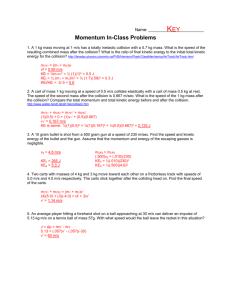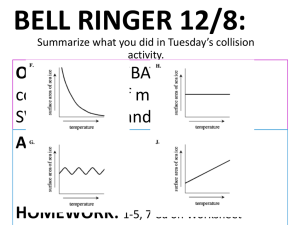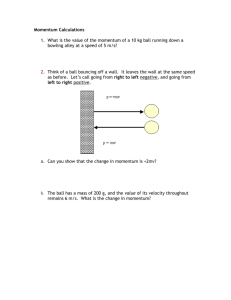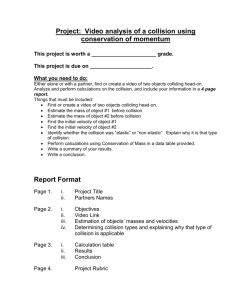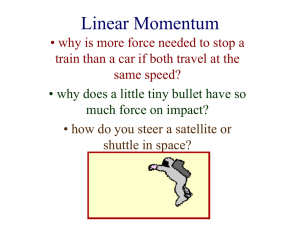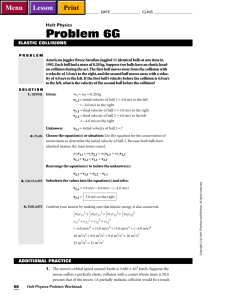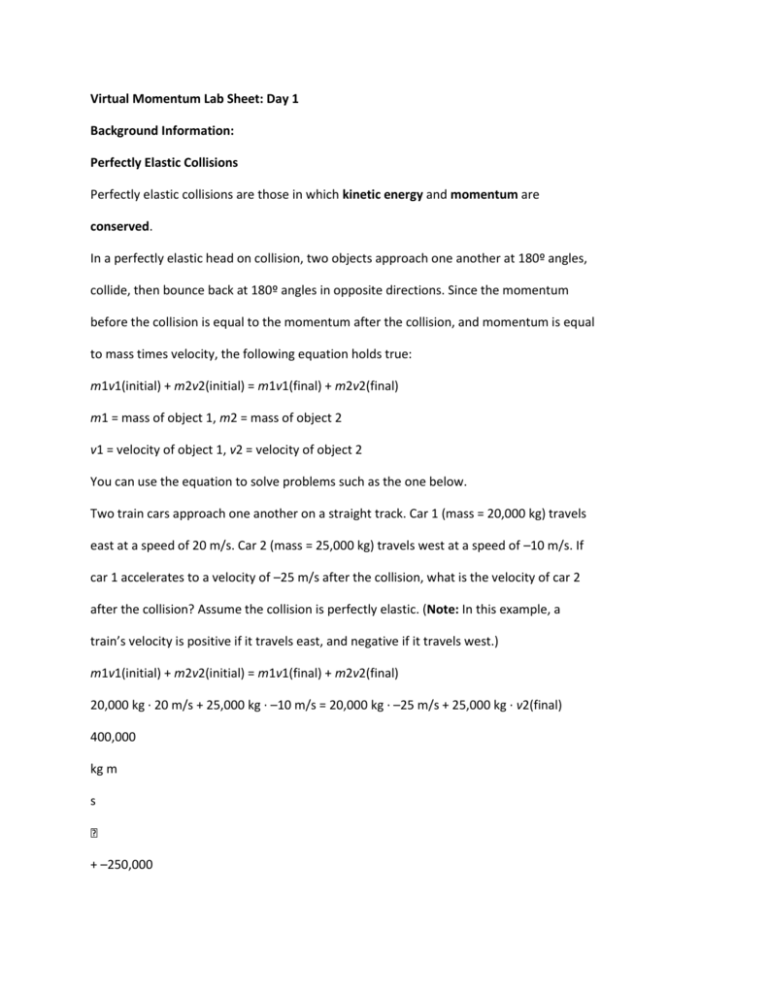
Virtual Momentum Lab Sheet: Day 1
Background Information:
Perfectly Elastic Collisions
Perfectly elastic collisions are those in which kinetic energy and momentum are
conserved.
In a perfectly elastic head on collision, two objects approach one another at 180º angles,
collide, then bounce back at 180º angles in opposite directions. Since the momentum
before the collision is equal to the momentum after the collision, and momentum is equal
to mass times velocity, the following equation holds true:
m1v1(initial) + m2v2(initial) = m1v1(final) + m2v2(final)
m1 = mass of object 1, m2 = mass of object 2
v1 = velocity of object 1, v2 = velocity of object 2
You can use the equation to solve problems such as the one below.
Two train cars approach one another on a straight track. Car 1 (mass = 20,000 kg) travels
east at a speed of 20 m/s. Car 2 (mass = 25,000 kg) travels west at a speed of –10 m/s. If
car 1 accelerates to a velocity of –25 m/s after the collision, what is the velocity of car 2
after the collision? Assume the collision is perfectly elastic. (Note: In this example, a
train’s velocity is positive if it travels east, and negative if it travels west.)
m1v1(initial) + m2v2(initial) = m1v1(final) + m2v2(final)
20,000 kg ∙ 20 m/s + 25,000 kg ∙ –10 m/s = 20,000 kg ∙ –25 m/s + 25,000 kg ∙ v2(final)
400,000
kg m
s
+ –250,000
kg m
s
= –500,000
kg m
s
+ 25,000 kg ∙ v2(final)
150,000
kg m
s
= –500,000
kg m
s
+ 25,000 kg ∙ v2(final)
+500,000
kg m
s
+500,000
kg m
s
kg m
650,000
s
25,000 kg
= 2(final) 25,000 kg
25,000 kg
v
26 m/s = v2(final)
If you substitute the value of v2(final) into the original equation, you can see that momentum
is conserved.
m1v1(initial) + m2v2(initial) = m1v1(final) + m2v2(final)
20,000 kg ∙ 20 m/s + 25,000 kg ∙ –10 m/s = 20,000 kg ∙ –25 m/s + 25,000 kg ∙ 26 m/s
400,000
kg m
s
− 250,000
kg m
s
= -500,000
kg m
s
+ 650,000
kg m
s
150,000
kg m
s
= 150,000
kg m
s
© 2011 Connections Academy, LLC. All rights reserved.
Perfectly Inelastic Collisions
Perfectly inelastic collisions are those in which momentum is conserved but kinetic
energy is not. Some of the kinetic energy of the colliding objects is converted into some
other form of energy such as heat or sound.
In a perfectly inelastic head on collision, two objects approach one another at 180º
angles, collide, stick together, and travel in the original direction of either object 1 or
object 2. The direction that they travel depends on the mass and velocity of each object.
Since the momentum before the collision is equal to the momentum after the collision,
and the final velocity of the objects is the same since they travel as one body after the
collision, the following equation holds true:
m1v1(initial) + m2v2(initial) = (m1+ m2)vfinal
m1 = mass of object 1, m2 = mass of object 2
v1 = initial velocity of object 1, v2 = initial velocity of object 2
vfinal = final velocity of both objects
You can use the equation to solve problems such as the one below.
Two train cars approach one another on a straight track. Car 1 (mass = 10,000 kg) travels
east at a speed of 10 m/s. Car 2 (mass = 15,000 kg) travels west at a speed of –20 m/s.
After the cars collide, they stick together and travel west because car 2 has a greater mass
and velocity than car 1. What is the final velocity of the two cars? (Note: In this example,
a train’s velocity is positive if it travels east and negative if it travels west.)
m1v1(initial) + m2v2(initial) = (m1+ m2)(vfinal)
10,000 kg ∙10 m/s + 15,000 kg ∙ –20 m/s = (10,000 kg + 15,000 kg)(vfinal)
100,000
kg m
s
+ –300,000
kg m
s
= 25,000 kg ∙ vfinal
kg m
-200,000
s
25,000 kg
= final 25,000 kg
25,000 kg
v
–8 m/s = vfinal
If you substitute the value of v(final) into the original equation, you can see that momentum
is conserved.
m1v1(initial) + m2v2(initial) = (m1+ m2)(vfinal)
10,000 kg ∙10 m/s + 15,000 kg ∙ –20 m/s = (10,000 kg + 15,000 kg)(–8 m/s)
100,000
kg m
s
+ –300,000
kg m
s
= (25,000 kg)(–8 m/s)
-200,000
kg m
s
= -200,000
kg m
s
© 2011 Connections Academy, LLC. All rights reserved.
Virtual Lab Procedures:
click on the “Proceed” arrow.
NOTE: In a perfectly elastic collision, the elasticity coefficient is always 1. The elasticity is already set at 1
and cannot be adjusted.
move the sliders to set the velocities. NOTE: The value of the velocity of Ball B is negative because the
value takes direction into account. (Objects traveling to the left will have a negative velocity while
objects traveling to the right will have a positive velocity.)
: ____________ Ball B: ___________
think the velocities changed as they did?
_____________________________________________________________________
_____________________________________________________________________
(post) the collision?
e in the space provided below.
_____________________________________________________________________
_____________________________________________________________________
set the masses and
initial velocities of balls A and B equal? How would the total momentum before and after the collision
compare? Click on the “Reset experiment” button and test your hypothesis. Record the results below.
_____________________________________________________________________
© 2011 Connections Academy, LLC. All rights reserved.
_____________________________________________________________________
s of Ball A
to twice that of Ball B and set their initial velocities equal? How would the total momentums before and
after the collision compare? Click on the “Reset experiment” button and test your hypothesis. Record
the results below.
_____________________________________________________________________
_____________________________________________________________________
do think would happen to the velocity of each ball after the collision if you set the initial velocity
of Ball A to twice that of Ball B and set their masses equal? How would the total momentums before and
after the collision compare? Click on the “Reset experiment” button and test your hypothesis. Record
the results below.
_____________________________________________________________________
_____________________________________________________________________
NOTE: In a perfectly inelastic collision, the elasticity coefficient is always 0. The elasticity is already set at
0 and cannot be adjusted.
can
move the sliders to set the velocities.
the space provided below.
_____________________________________________________________________
_____________________________________________________________________
© 2011 Connections Academy, LLC. All rights reserved.
o you notice about the total momentums before (pre) and after
(post) the collision?
_____________________________________________________________________
_____________________________________________________________________
equal? How would the total momentum before and after the collision compare? Click on the “Reset
experiment” button and test your hypothesis. Record the results below.
_____________________________________________________________________
_____________________________________________________________________

